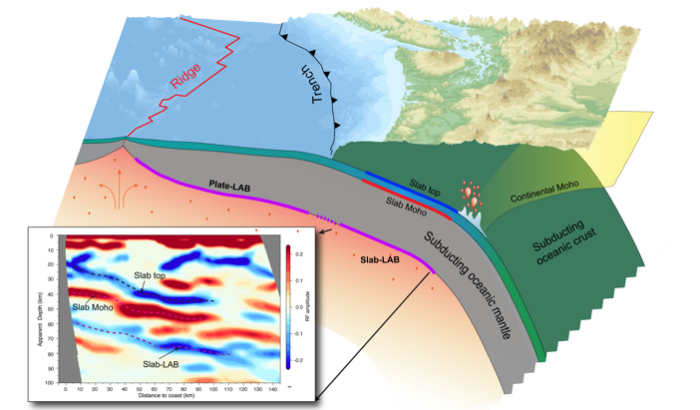Understanding the characteristics of the Lithosphere-Asthenosphere Boundary (LAB) is crucial for comprehending the mechanisms underlying plate tectonics. Traditionally, the LAB of oceanic plates is imaged as a seismic discontinuity, suggesting the presence of partial melts. However, the fate of a melt-rich LAB is unclear after these plates descend into the mantle at subduction zones (called the slab). In groundbreaking research led by Prof. WANG Xin at the Institute of Geology and Geophysics, Chinese Academy of Sciences(IGGCAS), seismic evidence has been presented indicating the presence of a melt-rich LAB at the base of the young Cascadia subducting slab. This finding has significant implications for the decoupling between the lithosphere and asthenosphere, potentially affecting subduction dynamics and the cycle of earthquake events. This work has been published in Nature Communications.
Historically, the presence of a subducting melt-rich LAB has been confirmed in subduction zones in Japan and New Zealand, where the subducting plates are considerably older (approximately 120-130 Ma). The existence of a melt-rich LAB beneath younger subducting plates, however, has remained unclear. Whether the occurrence of melt-rich LABs is influenced by the age of the slab poses significant questions with profound geodynamic consequences.
Prof. WANG Xin and his collaborators conducted extensive seismological research in the Cascadia subduction zone, where the incoming Juan de Fuca plate is approximately 10 Ma. Using ultra-dense seismic arrays and advanced imaging techniques, they successfully identified the LAB at the base of the Cascadia’s slab. Through in-depth multiple-frequency analysis and synthetic tests, the researchers observed a sharp reduction in seismic velocity within a narrow depth range of less than 3 km, strongly indicative of partial melts.
The characteristics of the slab-LAB beneath the relatively young, warm, and thin slab at Cascadia are similar to those observed beneath the older, colder, and thicker slab in the Japan trench. The substantial and sharp decrease in seismic velocity observed at both the older and younger slab bases, as well as along the base of oceanic plates prior to subduction, suggests that melt-rich LABs may occur irrespective of slab age and may be a common feature in subduction zones. The presence of melts at the slab LAB reduces viscosity, thus influencing subduction dynamics by facilitating lithosphere-asthenosphere decoupling. These findings are crucial for understanding subduction processes more broadly and may prompt further research into how variations in LAB rheology affect subduction-related earthquake cycles and associated hazards.
This research was conducted in collaboration with the California Institute of Technology and the Geological Survey of Canada, and supported by the National Key R&D Program of China, the National Natural Science Foundation of China, and the National Science Foundation.

Figure: Study area and resolved melt-rich Lithosphere-Asthenosphere Boundary along the base of the young-age Cascadia's subducting slab. (Image by Prof. WANG Xin)
Contact:
WANG Xin
Institute of Geology and Geophysics, Chinese Academy of Sciences
Phone: 86-010-82998600
E-mail: wangxin@mail.iggcas.ac.cn